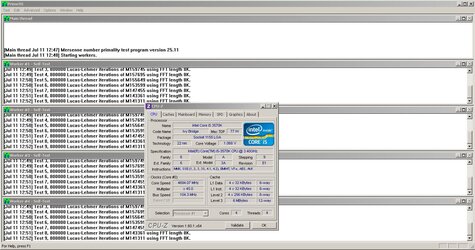- Joined
- Nov 3, 2008
Small FFT (64Bit) I might hit 98 on one core but that is about it and one core never gets over 87 either and the span between the core max temps bother me a bit. So I will have two cores floating in the low 90s and two in the high 80s
@4.7 I am not going to complain though.

Now I don't want to get into it with anyone here but the fact is Intel says the IB is safe up to 105º. They engage the hard core shut down at 130º.
So if you have complete overclocked stability at 99º doing some of the most stressful testing you can what is the problem? @ 105º the CPU will throttle anyway.
I am being serious here I am not looking for an argument or opinion here. Intel say 105º then throttle to keep it away from the 130º point. What studies have been done outside of Intel that say 99º @ 100% hardware stability is an issue?
Also I am in no way recommending running that hot I am just asking a question and to me the cooler you can keep it the better.
EDIT. OOPS: 90-99-99-93
I mean really http://www.techreaction.net/2012/07...-m3-a-new-weapon-for-your-gaming-conquests/6/ these temps were recorded with this OC
EDIT: Also Intel techdocs can be written in legalese. Like P.41 last paragraph http://www.intel.com/content/www/us/en/processors/core/3rd-gen-core-lga1155-socket-guide.html It almost seems like they are saying don't worry about the HSF because we have it covered.
@4.7 I am not going to complain though.

Now I don't want to get into it with anyone here but the fact is Intel says the IB is safe up to 105º. They engage the hard core shut down at 130º.
So if you have complete overclocked stability at 99º doing some of the most stressful testing you can what is the problem? @ 105º the CPU will throttle anyway.
I am being serious here I am not looking for an argument or opinion here. Intel say 105º then throttle to keep it away from the 130º point. What studies have been done outside of Intel that say 99º @ 100% hardware stability is an issue?
Also I am in no way recommending running that hot I am just asking a question and to me the cooler you can keep it the better.
EDIT. OOPS: 90-99-99-93
I mean really http://www.techreaction.net/2012/07...-m3-a-new-weapon-for-your-gaming-conquests/6/ these temps were recorded with this OC
EDIT: Also Intel techdocs can be written in legalese. Like P.41 last paragraph http://www.intel.com/content/www/us/en/processors/core/3rd-gen-core-lga1155-socket-guide.html It almost seems like they are saying don't worry about the HSF because we have it covered.
Last edited:
